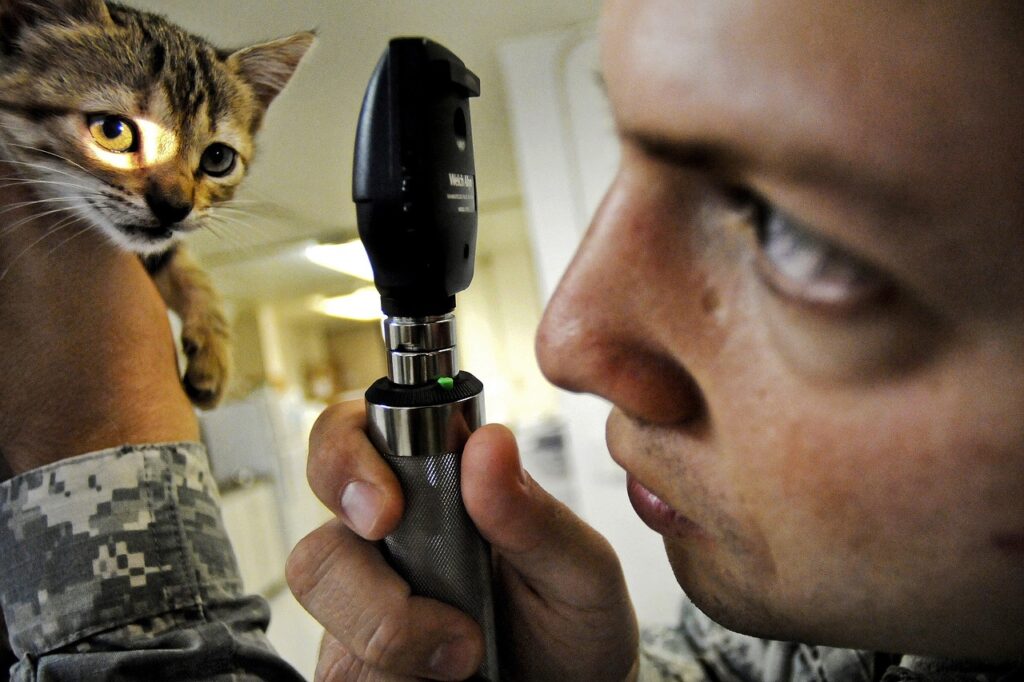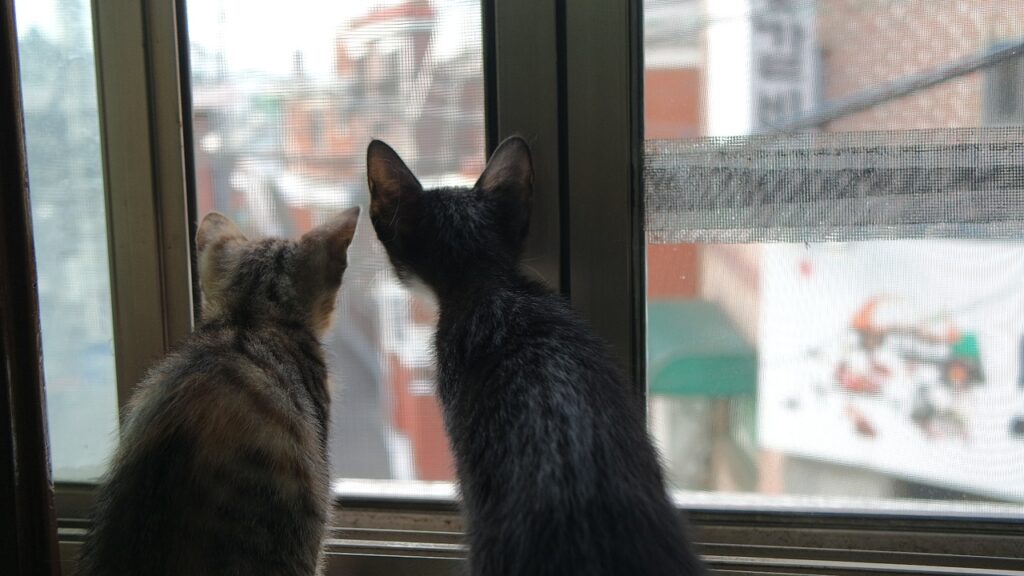Common Cat Diseases:
Common Cat Diseases: It can be an unpleasant shock for many cat owners to discover that their pets can be affected by several of the same diseases that affect humans.
Taking good care of your cat will prevent the occurrence of these diseases, but you need to start as soon as possible.
1. obesity
Just like humans, animals can become overweight and this will lead to a host of health problems in the future. Most domestic cats do not get enough exercise. Unlike outdoor cats, who often run or run around in search of food, indoor cats lead a sedentary lifestyle.
It is therefore important to make sure that you do not overfeed your cat. 3 small meals a day is much better than 2 large meals.
While most cats tend to eat according to the number of calories they have consumed, feeding too many treats tempts them to eat more food than they need.
Play with your cat often. You can train them to play fetch. Another way is to point a laser pointer at the floor and move it from point to point so your cat chases and jumps around.
If you have a cat tower in the house, your cat will be encouraged to climb more and move more. Giving your cat some toys to play with will help keep her occupied when you are not around.

2. diabetes
This disease tends to occur when the cat is overweight. So the best remedy is to keep your cat at an ideal weight. If your cat has diabetes, your vet will prescribe insulin which you can give to your pet.
It is important to detect diabetes in your cat early. Look for signs such as increased urination, weight gain, increased water consumption and/or a dull coat.
These are all signs of diabetes. Early detection will prevent your cat from becoming weak, blind or even in a diabetic coma.
3. liver disease
Common Cat Diseases: What You Need to Know: There are some types of liver diseases that affect cats. Hepatic lipidosis occurs when an enlarged liver is present. This is again caused by obesity. Just like in humans, a fatty liver is susceptible to disease.
Other liver diseases that a cat can be faced with are toxic liver damage, lymphocytic cholangitis, feline cholangitis and neutrophilic cholangitis.
The signs and symptoms you should look out for are Jaundice (yellowing of the gums, eyes, skin), increased urination, swelling of the abdomen, thirst, vomiting and loss of appetite.
Liver disease is a serious problem and requires professional veterinary care.
4. external and internal parasites
Fleas, ticks, lice, mites and worms (internally) are all examples of parasites that can infect your cat.
The ticks and fleas suck the blood of your cat as food, while the mites and lice live off the dead skin on your cat’s coat. These parasites can cause severe itching and can be a constant source of discomfort for your cat.
Gastrointestinal parasites such as roundworms, hookworms, tapeworms, etc. can also cause digestive and other health problems in your cat.
Again, your vet will be able to help you best. He will give you the flea/tick powder or sprays you need to eliminate all the harmful parasites that live on your cat. Follow the dosage instructions carefully.
For worms and internal parasites, your vet will either worm your cat or use other medical procedures to treat your cat. See a good vet and send your cat for treatment as soon as you notice any signs of misbehaviour.
Early detection and treatment will prevent health problems from worsening and speed up recovery. One stitch in time saves nine.

5 Tips for Feeding Your Cat
One of the many joys of being a cat owner is seeing your precious feline gracefully eating. Feeding your cat can be a minefield if you’re not aware of the territory.
Unlike dogs which are far more ‘enthusiastic’ when it comes to food, cats can be temperamental and have more specific dietary needs.
One common mistake that cat owners make is to leave a bowl of food out all the time and they expect the cat to eat whenever it feels like it. This is wrong.
There should be a fixed time of day when you feed your cat, and it’s best to measure the portion daily so that its diet is constant.
- Food requirements
Cats need a mix of both dry and wet food. Cat food sold in pet stores come in a variety of flavours and types. You’ll need to test out a few brands and see which brands your cat loves.
Yes! Just like us, cats have food preferences too. Some may prefer wet food, while others may prefer the dry biscuits. Either way, it’s good to have a mix in their diet.
On some days, give them dry foods that are grain-free. On other days, you can have wet food that’s made with meat or fish or poultry. You’re spoiled for choice here… and so is your cat. So, treat your pet to a variety of food.
Do note that it’s better to feed your cat a few mini-meals rather than a larger one. You do not want to overfeed your cat.
- Make mealtimes interesting
In the ‘wild’, cats are used to toying with their prey before killing and eating them. While this may seem cruel from a human perspective, for the cat, it stimulates their mind and keeps them mentally agile.
Since you can’t possibly have your cat playing with a rat before making a quick meal of it, what you can do is get a ‘slow feeder cat bowl’ which has grooves and niches for your cat to investigate while eating these ‘food puzzles’.
You can easily purchase such bowls from Amazon.com.
- Water/milk
Generally, cats do not drink much water and get their fluids from their food, but it’s best to have a water bowl for them to lap from if they’re thirsty. Dry food can make your cat want more water.
Storybooks and TV shows often make it seem like cats love milk. This is one of those facts that isn’t entirely true.
Many cats do not take too well to milk and if your cat is lactose-intolerant, this can lead to stomach issues. So, it’s best to avoid feeding your cat milk… unless it’s a kitten feeding from its mother.
- Feeding area
Ideally, there should be one specific place in your house where you place your cat’s feeding bowl and water. This area should not have too much human traffic.
Your cat may feel panicky or overwhelmed if there’s too much noise or activity around it when it’s trying to eat.
If you keep more than one cat, it’s best to have separate bowls for each cat and keep them apart from each other during meal times.
- Other points to note…
When buying cat food, it’s recommended that you test out the food by getting smaller bags in the beginning. There’s no point in buying a huge bag if your cat doesn’t like the food.
That said, if your cat does like the food, calculate how much food it needs daily. Then multiply that by 30 and buy a bag of food that roughly approximates this quantity.
Buying huge bags of food just to get cost savings might be a wrong move if the food gets spoiled or contaminated because it’s taking too long to be consumed.
Cats need some plant fibre in their diets to help them regurgitate the indigestible hairballs, etc. So, by including herbs in their meals, you’ll help to facilitate the process.
Only use these herbs – parsley, basil, cilantro, sage and thyme. Not all herbs are agreeable to a cat’s constitution.
Last but not least, if you’re planning on changing your cat’s diet, make sure you do so gradually. These sensitive creatures will have digestive problems if their diet is changed overnight. It’s best to speak to a vet before making major changes to the diet.
Your cat’s health is directly impacted by the food it consumes and the portions it’s given. Apply the tips in this article and your cat will be in great health.
How to Check the Health of Your Cat
One of the best ways to keep your cat in good health is early prevention. As they say, prevention is better than cure.
But how do you prevent your cat from getting sick and unhealthy?
As well as a healthy diet and making sure your cat is stimulated mentally and physically, prevention of illness starts with early detection. What you need to do is have a health check for your cat once a week.
Don’t panic. You don’t need to take X-rays or go to veterinary training. All you need to do is have a quick 5 to the 10-minute examination of your cat while you look for symptoms.
– Your cat’s behaviour
In general, you will want to look at your cat’s movements and alertness. If she seems slower or reacts less when you call her, something might be wrong.
– Physical signs/symptoms
Apart from a change in temperament or behaviour, there are several ways to see if something could be adversely affecting your feline friend.
Look at your cat’s eyes. Are they healthy, shiny and captivating?
If there is discharge, or the pupil in one eye seems larger than the other, this could be a sign that something is wrong.
What about your cat’s coat?
A healthy cat will have a smooth coat with no bald spots, parasites, dandruff, etc. If the coat looks dull and patchy, you should see the vet.
Feel the body of your cat. Is it smooth and healthy?
If your cat feels bony, there could be a nutritional problem. If you feel lumps and bumps that were not there before, it’s definitely time to take your cat to the vet.
A cat’s nose is another indicator of health. It should have no discharge and feel cool.
If your cat is constantly scratching her ears, there may be an irritation that requires further examination. Check your cat’s ears for infections, mites, etc. There should be no discharge or wetness in the ears.
If your cat limps or does not distribute her weight evenly on her paws, you should examine her more closely. In some cases, a scratch can cause an infection in the paw or a foreign body can become painfully lodged in the paw.
Oral hygiene is also important for a healthy cat. Examine your cat’s teeth and gums. There should be no tartar or bad smell. It is good practice to brush your cat’s teeth 2 to 3 times a week.
Depending on your cat’s temperament, this can be a smooth process or a struggle, but either way, it is something that needs to be done.
Oral health is one of the issues that also require veterinary attention. Bring your cat to the vet for a dental check-up every 6 months. Your vet can put your pet under a general anaesthetic so that he/she can clean the cat’s teeth and gums properly.
These are just some of the ways to check your cat’s health.
Keeping your home clean and making sure your cat eats well, moves around a lot and sleeps in a clean environment is crucial to keeping your furry friend healthy.
Important Advice for Cat Owners: Vaccinations, Neutering and Microchipping
These 3 words – vaccination, castration and microchip – can seem a little intimidating to many cat owners. They may wonder if they should do one of the three words and if there is any point to it all.
In this article, we’ll look at these three words in more detail, and you’ll understand how important these different procedures are and why they will help your feline friend.
– Vaccinations
Just as with humans, vaccinating your cat will help protect it from dangerous diseases. Even if you have a domestic cat, vaccination will help protect it from dangerous diseases.
Your vet will usually be the best person to advise you on what “core vaccines” your cat needs.
These core vaccines are recommended and necessary for cats all over the world: Feline Calicivirus (FCV), Rabies, Feline Herpesvirus 1 (FHV1), Feline Leukaemia Virus (FeLV – kittens) and Feline Panleukopenia Virus (FPV).
Depending on the situation, your vet may need to carry out a blood test on the cat to determine whether it needs certain vaccines, boosters, etc. In most cases, your cat will need a booster vaccination every few years to keep him healthy.
– Neutering
Castration, also known as neutering, is performed on female cats to prevent unwanted pregnancies. After neutering, female cats are less likely to run and cry.
Males are neutered (castration) to prevent them from reproducing and also to reduce aggression.
Ideally, they should be neutered when they are about 4 months old.
In general, castrated males are less likely to get into fights, roam around and spray to mark their territory.
Neutered cats also tend to live healthier and longer, and are less likely to develop prostate cancer.
– Microchip
Microchipping is a procedure in which a microchip implant is embedded under the cat’s skin. This makes it much safer than a collar or tag, as the microchip cannot be accidentally removed and lost.
The procedure is painless and the chip is extremely small (about the size of a grain of rice). Your cat will not even know it is there.
Once the microchip is in place, it has a unique code that is uploaded into the database with details of the owner.
If your cat ever decides to wander around and be found by others, a quick scan of the microchip will reveal her home address and your cat will be returned to you.
Cat shelters routinely scan for microchips in the hope of returning lost cats to their owners. This also helps prevent overcrowding in the shelters.
The microchip will last a lifetime, but it’s a good idea to have it scanned once a year to make sure it’s working properly.
The 3 procedures mentioned above are essential for every cat owner. Normally your vet can do all 3 for you. The cost of the procedures is affordable and the cost is worth it just to keep your cats safe and healthy.
Owning a cat is a lifelong responsibility – a cat’s lifetime, to be precise. Be kind and care for them… and she will love you well.
As Charles Dickens said: “What greater gift than the love of a cat?
Useful Pointers on Keeping Your Cat Happy Indoors
Cats are curious creatures by nature. They love to wander around and explore their surroundings.
They love to explore their surroundings and enjoy the mental stimulation that comes with new sights and sounds.
– What makes a cat unhappy?
A cat kept indoors can quickly fall into lethargy and boredom if it is not given enough activities to keep its mind and body active.
A common symptom is a cat that sleeps a lot. Cats do like to sleep, but if they sleep all the time, they are likely to be bored to death and depressed.
– How to solve the problem
The best way to make your cat happy is to take a few proactive steps to make her life more interesting.
For a start, you can let your cat out into your garden, but keep it fenced in so it won’t jump out. The new environment will make them curious.
At home, you should have a few cardboard boxes and perhaps a spare shelf in a cupboard so that your cat can curl up in it. Cats love privacy, and you should respect their privacy when they hide in these darker, quieter areas.
Movement is very important for your pet. Most cats love climbing and this activity helps them burn calories.
It is difficult for domestic cats to burn their calories because there is not much opportunity for exercise.
This can lead to obesity, which then leads to serious health problems.
A good way to get your indoor cat to climb is to put up a climbing post in your home. You can easily buy one at Amazon.
A good climbing post is wrapped in sisal carpet/rope to make climbing easier. Some of the posts will have a ball attached to a string so that the cat can fumble around and play on it.
This is for mental stimulation. Ideally, you should have a post that reaches from floor to ceiling and can be taken apart when not in use.
A perch or shelf near the top of the climbing post will help your cat find a place to rest and sit down while watching the world from above. This is similar to the way big cats sit and rest on tree branches in the wild. Her domestic cats may be smaller and tame, but they still have similar natural instincts.
The best way to get attached to your cat is to play with him. While dogs need much more playtime, 5 to 10 minutes (twice a day) is enough for cats.
Have some toys that you can dangle in front of them to excite them. Or use a laser pointer to make them chase the red dot.
Alternatively, you can carve holes of different sizes in a few large cardboard boxes and create a maze. Then place your cat in them so that he can “explore” this new challenge.
To keep your cat happy, all you have to do is give him the opportunity to tap into his instincts.
Give her places to hide, corners to explore, a safe high seat to scan her surroundings, and perhaps some wooden planks that go from point to point so your cat can walk across these planks like a tightrope walker.
Of course, there should be a way to access these boards. So you could set up a ramp or a few stacks of books of different heights etc. so that your cat can reach the boards. They are only limited by your imagination.
An indoor cat is safe from threats and will live much longer than an outdoor cat, but the only drawback is the lack of stimulation it experiences indoors.
If you can fill this gap and give your cat the mental and physical stimulation it craves, you will have a happy and contented cat that loves being around you.
Very much hope you have found my latest article of interest to you can helpful.
For Fresh Catnip visit our shop here
The post Common Cat Diseases: appeared first on Catnip Utopia.
The post Common Cat Diseases: appeared first on GQ Central.



Comments are closed